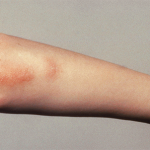Three weeks later, however, the boy was back in the clinic with persistent fevers, breathing problems, and a new petechial rash. His laboratory studies had also changed remarkably, notes Dr. Verbsky. Those results showed that the patient’s white blood cell, hemoglobin, and platelet counts were dropping, a factor inconsistent with a SJIA flare. He also had elevated triglycerides and a high ferritin level (26,000 ng/mL).
These latter results, said Dr. Verbsky, raised a red flag for the clinicians. “When you see cytopenias in a patient with systemic [juvenile rheumatoid arthritis], low fibrinogen, and a high ferritin level, this should raise concerns of MAS,” he noted. The patient was then diagnosed with MAS in association with systemic JIA, and started on the HLH 2004 protocol—comprised of etoposide, dexamethasone, and cyclosporine—and began to improve. Dr. Verbsky called this a “classic presentation of systemic JIA and how it can revert quickly to MAS.”
His second case was a 15-year-old girl whose symptoms met all the clinical criteria for lupus, but who also had unusual features of pancreatitis and hepatitis. She did not respond well to oral prednisone and returned with very high fever as well as elevated triglyceride and ferritin levels. A bone marrow biopsy validated hemophagocytosis, which explained her hepatitis, said Dr. Verbsky. She was diagnosed with MAS in association with systemic lupus erythematosus and admitted to the hospital for aggressive inpatient therapy.
Closing in on Diagnosis
Pediatric rheumatologists are increasingly aware of MAS and this is contributing to its earlier diagnosis, said Dr. Grom. Clinicians should consider the possibility of MAS if their patients have cytopenias, disease that is unresponsive to steroids, unusual organ involvement, and persistent high fevers. Ideally, he said, the diagnosis of MAS should be confirmed by demonstration of hemophagocytic macrophages in the bone marrow, but in some patients these cells accumulate in the lymph nodes, liver, or skin. Sampling errors can also confound bone marrow aspiration results.
Two laboratory tests are useful in diagnosis and monitoring of treatment response, Dr. Grom reported. When T cells and macrophages are overly activated, they shed some of their scavenger receptors, including soluble IL2 receptor and soluble CD163 molecules. Wherever the macrophages accumulate—the bone marrow, lungs, liver, or lymph nodes—they shed these molecules, which can be detected in the peripheral circulation.4 “That’s the reason these two tests may be very helpful in terms of early diagnosis and management of the treatment,” he said. That is also good news in light of evidence that there may be far more cases of occult MAS in juvenile patients than formerly thought.5
